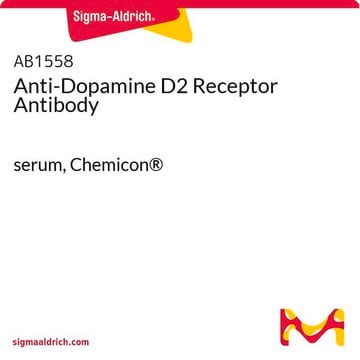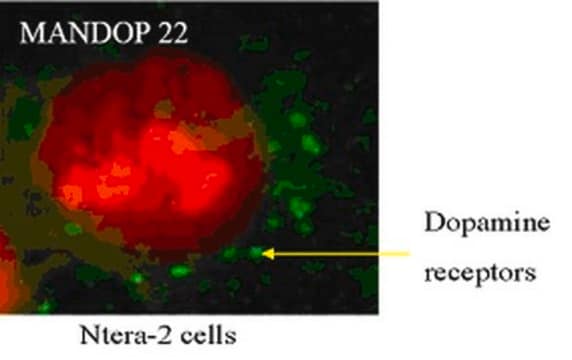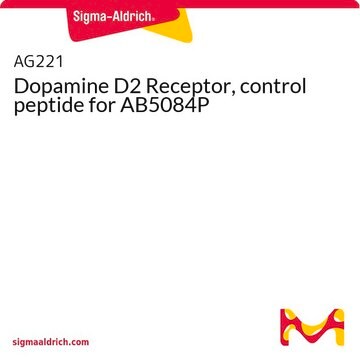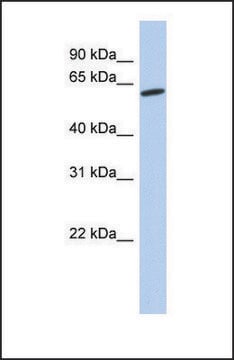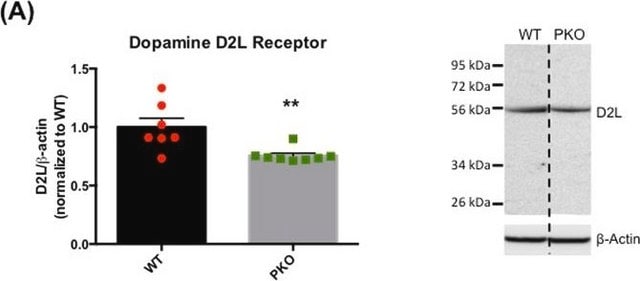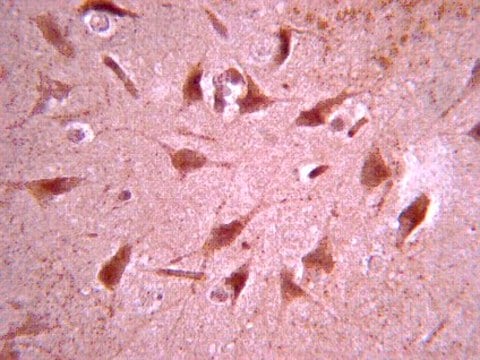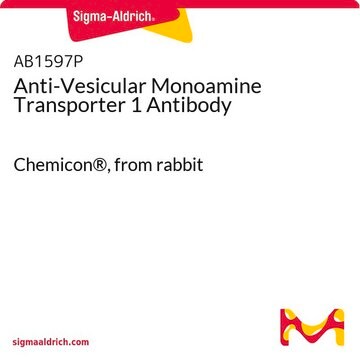AB5084P
Anti-Dopamine D2 Receptor Antibody
Chemicon®, from rabbit
Synonym(s):
Dopamine D2 receptor
About This Item
Recommended Products
biological source
rabbit
Quality Level
antibody form
affinity isolated antibody
antibody product type
primary antibodies
clone
polyclonal
purified by
affinity chromatography
species reactivity
mouse, monkey, rat, human
manufacturer/tradename
Chemicon®
technique(s)
ELISA: suitable
immunohistochemistry: suitable
immunoprecipitation (IP): suitable
western blot: suitable
NCBI accession no.
UniProt accession no.
shipped in
dry ice
target post-translational modification
unmodified
Gene Information
human ... DRD2(1813)
mouse ... Drd2(13489)
rat ... Drd2(24318)
rhesus monkey ... Drd2(694181)
General description
Specificity
Immunogen
loop #3.
Application
Neuroscience
Neurotransmitters & Receptors
1-10 µg/mL (Chemiluminescence technique) The predicted size of D2 is approximately 50 kDa. However, additional bands at approximately 68 and 100 kDa, and others are typically seen in various tissues (Boundy et al. 1993; Sakata et al. 1992; Farooqui et al. 199; Farooqui & Prasad 1992, BBRC; Brock et al. 1992; Farooqui & Prasad 1992, Life Sci). Approximately 100-400 µg of membrane protein/lane should be loaded to visualize various bands.
Immunohistochemistry:
2-10 μg/mL on paraformaldehyde fixed sections on a previous lot.
Immunohistochemistry:
1-20 µg/mL on paraformaldehyde fixed sections.
Immunoprecipitation:
1-10 μg/mL using 100-400 μg of protein on a previous lot. An antibody made to this epitope has been shown to immunoprecipitate both the long and short forms (2).
ELISA:
0.5-1.0 μg/mL (1 μg/mL immunogen peptide (Catalog number AG221)/well) of a previous lot was used on ELISA.
Optimal working dilutions must be determined by the end user.
Quality
Western Blot Analysis: 1:1000 dilution of this lot detected Dopamine Receptor D2 on 10 μg of human brain lysates.
Target description
Physical form
Storage and Stability
Analysis Note
Monkey brain tissue, rat brain lysate
Other Notes
Legal Information
Disclaimer
Not finding the right product?
Try our Product Selector Tool.
Storage Class Code
12 - Non Combustible Liquids
WGK
WGK 2
Flash Point(F)
Not applicable
Flash Point(C)
Not applicable
Certificates of Analysis (COA)
Search for Certificates of Analysis (COA) by entering the products Lot/Batch Number. Lot and Batch Numbers can be found on a product’s label following the words ‘Lot’ or ‘Batch’.
Already Own This Product?
Find documentation for the products that you have recently purchased in the Document Library.
Customers Also Viewed
Our team of scientists has experience in all areas of research including Life Science, Material Science, Chemical Synthesis, Chromatography, Analytical and many others.
Contact Technical Service
